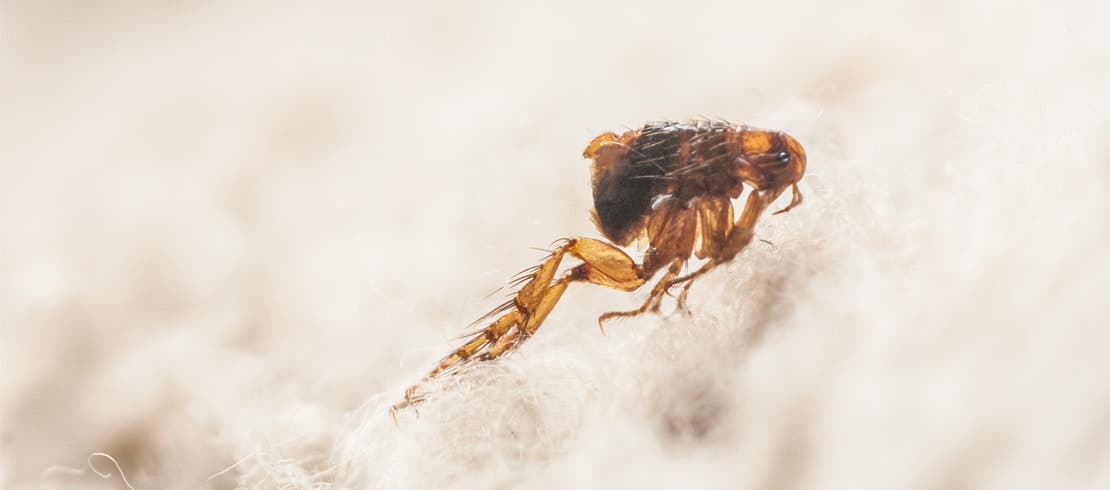Fleas and ticks are common bugs that cause irritating bites and can transmit diseases to your pet. Here's what you need to know about each.
As warm and snuggly as our pets might be to us, their soft fur also provides a great environment and hiding place for some nasty bugs. That's right, we're talking about two of the most common threats for both pets and their owners: fleas and ticks.As warm and snuggly as our pets might be to us, their soft fur also provides a great environment and hiding place for some nasty bugs. That's right, we're talking about two of the most common threats for both pets and their owners: fleas and ticks.
Fleas and ticks are similar in that:
- They feed on your pet's blood.
- They can transmit diseases.
- They use sharp mouthparts to cut into the skin where they access blood vessels, often leaving red irritated skin behind.
- They can spread disease to humans and pets.
But that's where the similarities end.

Flea vs. Tick
There are many differences between fleas and ticks, including:
- The type of parasite they are: A flea is a wingless insect with six legs that can jump. Ticks, on the other hand, have six to eight legs and are arachnids, which means they're related to spiders.
- The hosts they look for: Adult fleas find one host, usually a dog or cat, and stay there until they die (their lifespan on a pet can last two to three months). Ticks feed on multiple hosts (rodents, rabbits, deer, and pets) up to two weeks at a time throughout the different stages of their development and can live up to three years in various environments.
- The weather they can tolerate: In most cases, we think of flea and tick season as the warmer months, and for fleas, that's true. Warm environments are ideal for them. Ticks thrive in warmer environments too, but are better adapted to survive the cold weather, even hiding under snow.
- Their tendency to infest your home: Fleas are more likely to infest your house. They multiply, they bring along friends and they can get on your clothes and your furniture. Ticks typically just wait around and latch onto their host as they walk by.
- The way you treat them: If you have a flea infestation, you'll most likely need to use a premise product to clean and treat the areas of your house exposed to the infestation, as well as give your dog a flea bath, or treat your pet with a preventive. With ticks, you will want to remove them as quickly as possible and even give the pet a bath if they are heavily infested. To avoid ticks in the future, be sure to apply a preventive.
- The diseases they carry: Fleas can cause skin issues, flea allergy dermatitis, and carry tapeworms. Infected ticks can transmit potentially deadly diseases like Rocky Mountain spotted fever and Lyme disease.

Avoiding Fleas and Ticks
Always check your dog or cat after they have come in from a romp in the woods or tall grasses. If you do find a tick on your pet, get rid of the parasite as quickly as possible, clean the area, and monitor your pet for any changes in behavior. And if you find fleas, clean, bathe, and treat your pet appropriately. Consult your vet if you have any specific concerns.

Credelio® (lotilaner)
As a trusted resource, your vet can provide additional information on how prescription-only Credelio can protect your dog from ticks and fleas all year long when taken monthly.

Credelio® CAT (lotilaner)
Protect your feline friend with Credelio Cat, the first and only flea and tick chewable for cats.

Seresto® Flea & Tick Collar for Dogs
An easy-to-use, odorless, non-greasy collar that kills and repels fleas and ticks for 8 continuous months.

Seresto® Flea & Tick Collar for Cats
An easy-to-use, odorless, non-greasy collar that kills and repels fleas and ticks for 8 continuous months.

K9 Advantix® II
A convenient, monthly topical application that kills and repels fleas, ticks and mosquitoes through contact, so they don't have to bite your dog to die. Do not use on cats.
Credelio® (lotilaner)
Indications:
Credelio kills adult fleas and is indicated for the treatment and prevention of flea infestations and treatment and control of tick infestations (lone star tick, American dog tick, black-legged tick, and brown dog tick) for one month in dogs and puppies 8 weeks and older and 4.4 pounds or greater.
Important Safety Information:
Lotilaner is a member of the isoxazoline class of drugs. This class has been associated with neurologic adverse reactions including tremors, incoordination, and seizures. Seizures have been reported in dogs receiving this class of drugs, even in dogs without a history of seizures. Use with caution in dogs with a history of seizures or neurologic disorders. The safe use of Credelio in breeding, pregnant or lactating dogs has not been evaluated. The most frequently reported adverse reactions are weight loss, elevated blood urea nitrogen, increased urination, and diarrhea. For complete safety information, please see Credelio product label or ask your veterinarian.
Credelio® CAT (lotilaner)
Indications:
Credelio CAT kills adult fleas and is indicated for the treatment and prevention of flea infestations for one month in cats and kittens 8 weeks of age and older and weighing 2 pounds or greater.
Credelio CAT is also indicated for treatment and control of black-legged tick infestations for one month in cats and kittens 6 months of age and older and weighing 2 pounds or greater.
Important Safety Information:
Lotilaner is a member of the isoxazoline class of drugs. This class has been associated with neurologic adverse reactions including tremors, incoordination, and seizures. Neurologic adverse reactions have been reported in cats receiving isoxazoline class drugs, even in cats without a history of neurologic disorders. Use with caution in cats with a history of neurologic disorders. The safety of Credelio CAT has not been established in breeding, pregnant and lactating cats. The effectiveness of Credelio CAT against black-legged ticks in kittens less than 6 months of age has not been evaluated. The most frequently reported adverse reactions are weight loss, rapid breathing and vomiting. For complete safety information, please see Credelio CAT product label or ask your veterinarian.


